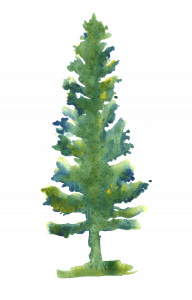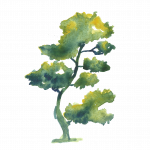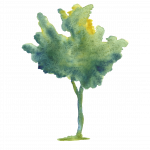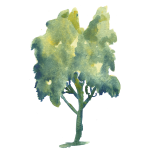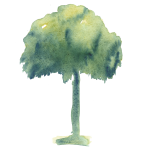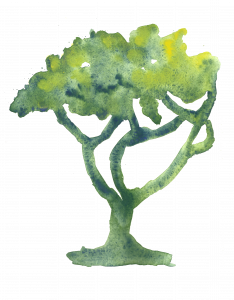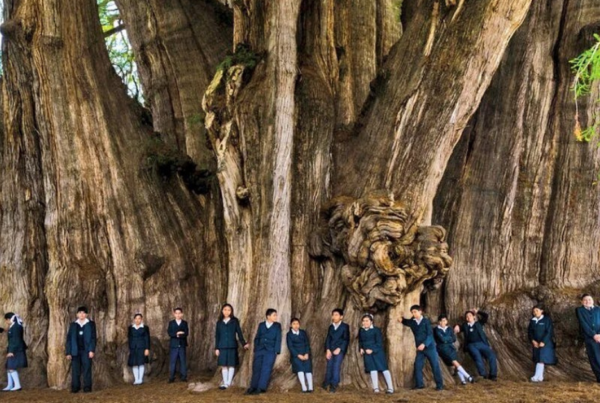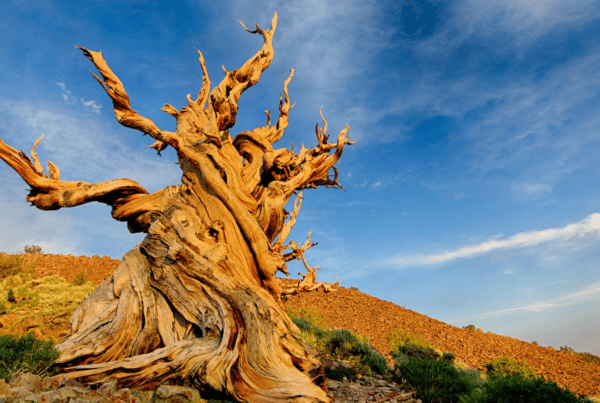“A powerful call now rings around the world; everyone hears it, but…”
Trees are an essential resource for our society. In this post, we’re going to talk about the many benefits of trees. We hope we can help to raise awareness of their importance!
Let’s start at the beginning… the very beginning.
Plants, which appeared on Earth over 420 million years ago, were a major step in evolution. Cyanobacteria entered other micro-organisms and merged their chlorophyll – the pigment which allows photosynthesis – thus creating plant cells. From this came the development of seaweed, making it possible for plants to colonize dry land.
Thus arose the first forests. And from these first steps, ancient trees and plants conquered almost all of the terrestrial biomes.[1] Today, our planet has more than 300,000 plant species, many of which are necessary for all forms of life on earth.
The climate emergency is one of today’s most pressing issues, and plants are a critical part of the solution. Trees absorb CO2 through photosynthesis, and this can help to offset greenhouse gas emissions and reduce the effects of climate change.
We’ve covered that in more detail here. But right now, we’re going to focus on all the other ways that trees are essential to a good quality of life.
Ecological functions
 The oxygen-producing tree, source of life
The oxygen-producing tree, source of life
Like almost all plants, trees are autotrophic organisms. They make their own food, allowing them to grow, reproduce and transmit their characteristics to the next generations of plants through genes. They are also almost the only organisms that produce organic substances from inorganic materials: photosynthesis allows them to transform the light energy of the sun into glucose and to produce oxygen. This oxygen is released into the atmosphere and is vital to animal life on earth.
So, these photosynthesizing plants are the basis of the food chain. And without them, many species – like plants without chlorophyll, herbivores, and even some omnivores or carnivores – could not survive.
Similarly, we depend on these trees and plants to produce the oxygen we need to live.
DID YOU KNOW:
A mature tree produces an average of 120 kg of oxygen per year, which is half of an adult’s annual consumption.
The air purifying tree
Plants, more precisely trees, are specialists in air filtration. They take in air that contains pollutants and dust, clean it by removing these particles from the air, and release it back to us. Thus, they can dramatically improve air quality.
The amount absorbed varies. For some species, like a mature maple, a single tree can collect up to 20 kilograms of dust per year. A street lined with mature trees contains up to 4 times less atmospheric dust than a street without trees![2]
Several species, like elm, beech, alder, and willow, are known for their high pollution filtration. On the other hand, other varieties such as the big fruit oak, Virginy ostry, and Rhus typhina can retain more dust in their fluffy leaves.
The tree: synonymous with biological diversity
The term biodiversity refers to all the species and ecosystems of a given region or natural environment. This diversity of organisms is a fundamental measure of the health of the environment.
When plant species become extinct as a result of climate change, it may result in the extinction of a variety of animal species.[3]
DID YOU KNOW:
In the Canadian province of Quebec, there are more than 40,000 wild animal and plant species living in harmony – many of which depend on forest ecosystems.
The tree fights against soil erosion
Trees help combat soil erosion, which frequently occurs in urban areas due to development and deforestation. Tree roots keep the soil in place on sloping ground and, near rivers, help to avoid riverbanks collapsing.
When plant cover is lacking, the soil is exposed directly to the rain. This can have major long-term repercussions on soil structure, and cause loss of minerals and soil itself through runoff. This type of degradation is particularly pronounced for sloping lands, streambanks and riverbanks, cliffs, and hills, from which trees and plants have been removed.
The tree improves water quality
In addition to regulating water and stabilizing soils, trees and forests also help to maintain water levels. Forests store water, thereby reducing evaporation; modering the melting of snow; and tempering both floods and droughts.
Just like tree leaves for the air, tree roots are excellent water filterers and can absorb a large amount of runoff water – often loaded with fertilizers or other pollutants. By limiting the number of pollutants that flow to rivers, trees help to avoid over-fertilization of water bodies, and thereby decrease the development of algae and other unwanted aquatic plants.
The tree helps to regulate extreme temperature differences
Living trees transpirate by absorbing water from their roots, passing it through their tissues, and releasing it as vapor. This affects local humidity and cloud cover, and tempers extreme variations in climate. Numerous scientific studies have shown that deforestation negatively affects rainfall and climatic conditions for the rest of the forest.
The tree protects against heat
Trees refresh the ambient air by providing heat protection. Several studies show that the air temperature in urban woodlands is generally cooler than that in a tree-free environment. The transpiration of a mature tree that cools ambient air is equivalent to 5 air conditioners operating at full capacity![4]
Trees’ foliage also offer protection against solar radiation by absorbing and reflecting it, thereby reducing its intensity and heat – and making life more comfortable for us. In addition, they allow the creation of shade on land, offering cooler spaces in case of high temperatures. Think of how refreshing a cool urban park is on a hot day.
The tree protects against rain
Tree cover protects us from precipitation by intercepting droplets and snow. Conifers are champions of this: they can intercept up to 40% of precipitation, unlike hardwoods of the same size which intercept only 20%.[5]
Trees and plants can improve arid and disturbed sites
Several nutrients are essential to the survival of plants, such as nitrogen, phosphorus, and potassium. Certain small trees or plants, such as legumes like Gliricidia spp., can collect nitrogen. These ‘nitrogen-fixing’ plants maintain a mutually beneficial relationship with Rhizobium bacteria.
The bacteria obtain energy from photosynthesis and, in exchange, fix nitrogen into the form required by the plant. The fixed nitrogen is then transported to other parts of the plant where it is used to form plant tissues. Nitrogen is released either immediately or when the plant dies and decomposes, fertilizing the soil and promoting the growth of other plants.
The tree is a natural windbreak
As anyone who has seen a tornado or sailed a sailboat can attest, winds can be very powerful. A gentle breeze may be lovely, but a gale can cause massive damage. Trees have the capacity to decrease wind speed thanks to their leaves, branches, and foliage, which create resistance to air.
DID YOU KNOW:
A dense stand of vegetation can reduce air speed by as much as 50%!
The degree of reduction will depend on the height of the vegetation, its density, and the permeability of the plants used – but what’s for sure is that it has a major effect. That’s why we find trees used as windbreaks along many highways or straight streets.
The tree attracts wildlife
Thousands, if not millions, of animal and plant species, depend entirely on vegetation for their survival. Mammals, birds, and insects use trees as shelter, protection, and food. Macaws, like in our Tambopata project, nest in trees, eat their fruit and hide in their leafy cover to protect themselves from predators. So do many forest animals, like bonobos in the Congo.
The tree protects against noise
Tree leaves are highly effective at protecting against ambient noise from city life and road traffic. A belt of trees along the road can reduce ambient noise by 6 to 8 decibels![6]
Aesthetic functions
The tree as an architectural element
Urban environments can easily become cold and impersonal. Adding vegetation such as trees breaks the monotony and adds warmth and complexity. When appropriately arranged, trees and man-made architecture can live in perfect harmony.
The screen tree
Trees are often used to delimit large outdoor spaces. In residential areas, hedges or very tall trees are used to maintain the privacy and privacy of homes. Trees can also delimit residential and high-traffic areas of industrial zones, creating a natural screen against noise. And in the worst case, you can also use plants with thorns to keep away wanted animals, creatures, or even some humans!
Social functions
The ornamental tree and its psychological effect on humans
The sweet scent of lilac flowers and apple or cherry trees when spring blossoms; mature trees that shade us during summer heat; the brilliant colors of the fall; pine boughs creaking under the weight of snow in winter: trees constantly remind us that life is everywhere around us and that it ebbs and flows with the rhythm of the seasons.
Ornamental trees with spectacular flowers, bright colors, and superb foliage bring us variability in colors, textures, and shapes, greatly improving the aesthetics of landscapes in our cities. Humans are naturally inclined towards beautiful environments, and these trees improve our subconscious well-being.
The tree and quality of life
Many scientific studies have shown that access to trees and forests is a source of well-being and mental health for city dwellers. Some studies have even found that exposure to trees through urban green space lessens disease!
Not to mention the Japanese practice of forest bathing – just spending time in the forest – which decreases stress and can produce a host of benefits, from improved heart function to lower blood pressure, better metabolism, improved moods, quicker recovery, and alleviating anxiety and depression.[7] And doctors in Canada can now prescribe a ‘National Parks Pass’ to their patients in need of decompression time.
The tree and recreation
Wilderness reserves, national parks, urban parks, and outdoor centers are special places. They provide recreation and gathering spots for activities like hiking or mountain biking or just for relaxation and spending time in the outdoors, and also protect important wildlife and ecosystems like old-growth forest.
The tree and environmental education
Several municipal parks in large cities offer points for observing flora and fauna. These sites raise awareness of the importance of conservation. Interpretation sites are also available in certain urban settings, allowing citizens, tourists, and students to better understand the complexity and nuances of the natural world.
The tree and medicine
Extracts of plant species have been used to make powerful remedies for centuries. Indigenous peoples around the world have used different herbs to cure, prevent and treat various diseases. These remedies were and are administered in multiple ways: some could be brewed into teas; some are chewed, and others are inhaled.
Plant organisms are also used to create a fair number of drugs in industrialized societies. The bark of willow, for example, is used to develop aspirin, and the only bacteria to fight antibiotic-resistant superbugs was discovered in the soil of a Nova Scotia national park.
Protecting our ecosystems ensures that we protect their potentially lifesaving properties for future generations.
Economic functions
The tree: fruit production and crop support
Fruit-producing trees such as pear, apple, plum, and cherry have significant economic value. Trees and forests also host bees, birds, and other pollinators, which help to increase yields for famous crops that are planted nearby, like coffee or cacao.
The tree: economic engine
Trees in an urban environment create economic value by generating many jobs in arboriculture, horticulture, and tree maintenance. In most municipalities, particular importance is given to these fields, with the aim of preserving and conserving urban trees and urban flora. Of course, this can also include the unpleasant job of removing dead trees or pruning trees that have become a danger to a nearby house!
The tree: tourist attraction
Urban parks provide spaces for people to relax and play and are a significant economic asset for a municipality. And the most spectacular of them attract tourists – think of Central Park in New York City.
The tree: energy saving
A well-placed tree at the side of a residence can help reduce heating costs in the winter by acting as a protective barrier against cold winter winds. Similarly, during hot days in the summer, trees near the house can help keep things cool, reducing the need for air conditioning. Trees also help to reduce the ‘urban heat island effect’, a phenomenon by which dense buildings retain heat, increasing the temperature in urban areas by several degrees in some cases.
The tree: wood and building materials
Trees and forests provide many indispensable resources, like building materials, lumber, firewood, or pulp. People in rural areas of developing countries often live next to forests and rely heavily on them daily for these resources. This also reduces their reliance on often inconsistent incomes, and thus lowers the risk of poverty.
In industrialized countries, every consumer uses products from the processing of woody material every day. When you order something from Amazon, it comes in a box; any packing slip will be printed on paper; and if you are lucky these days, you will get a paper-based biodegradable bubble mailer for small items! Managing trees and forest resources sustainably is, therefore, essential if we want to continue to rely on them in the long term.
The tree: the sugar maple🍁
An article about all the amazing things trees do for us wouldn’t be complete without maple syrup. The sugar maple is iconic in Canada, and especially Quebec, which produces almost three-quarters of the world’s maple syrup supply. The sap of these trees is gathered and transformed into syrup every spring. The variety of maple-flavored products derived from this sap is highly sought after and has significant economic value for local producers.
The tree: accident inhibitor
Well-placed trees and plants can reduce the number of road accidents. Trees along highways, for example, reduce wind gusts, prevent glare when the sun is near the horizon, and reduce blowing snow during the winter. Trees on the side of a ski run improve the visibility of nearby snow, making skiers less likely to crash.
The tree: financial gain of a property
The presence of trees on a property can increase home value by 10 to 23% and in some cases up to 30%![8] The presence of trees and greenery also tends to increase the value of neighboring residences.
What’s more, residential neighborhoods with parks, wooded areas, green spaces, and magnificent trees are always in high demand. Properties located in these areas are generally more expensive in the real estate market since buyers will often pay more to be close to these soothing and peaceful spaces.
“Wherever the tree has disappeared, man has been punished for his improvidence.”
These words of Châteaubriand sum up well the capital contribution of the tree in our lives.
“We see in which regrettable ends this attitude, this operating mentality has led us. The tree is not only an economic contribution, it is also a precious contribution to our well-being.”
You can help keep our spectacular trees standing. On average, $1 protects one tree.

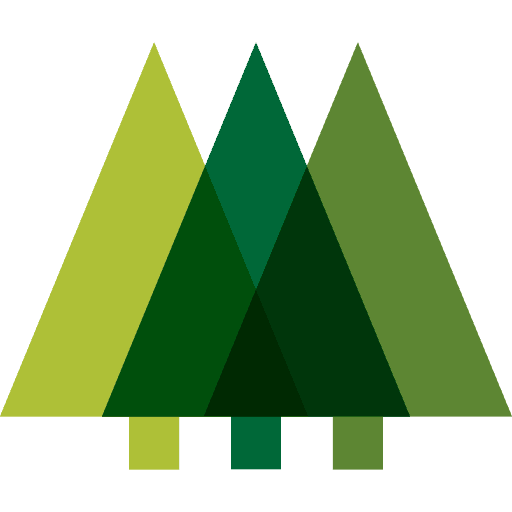

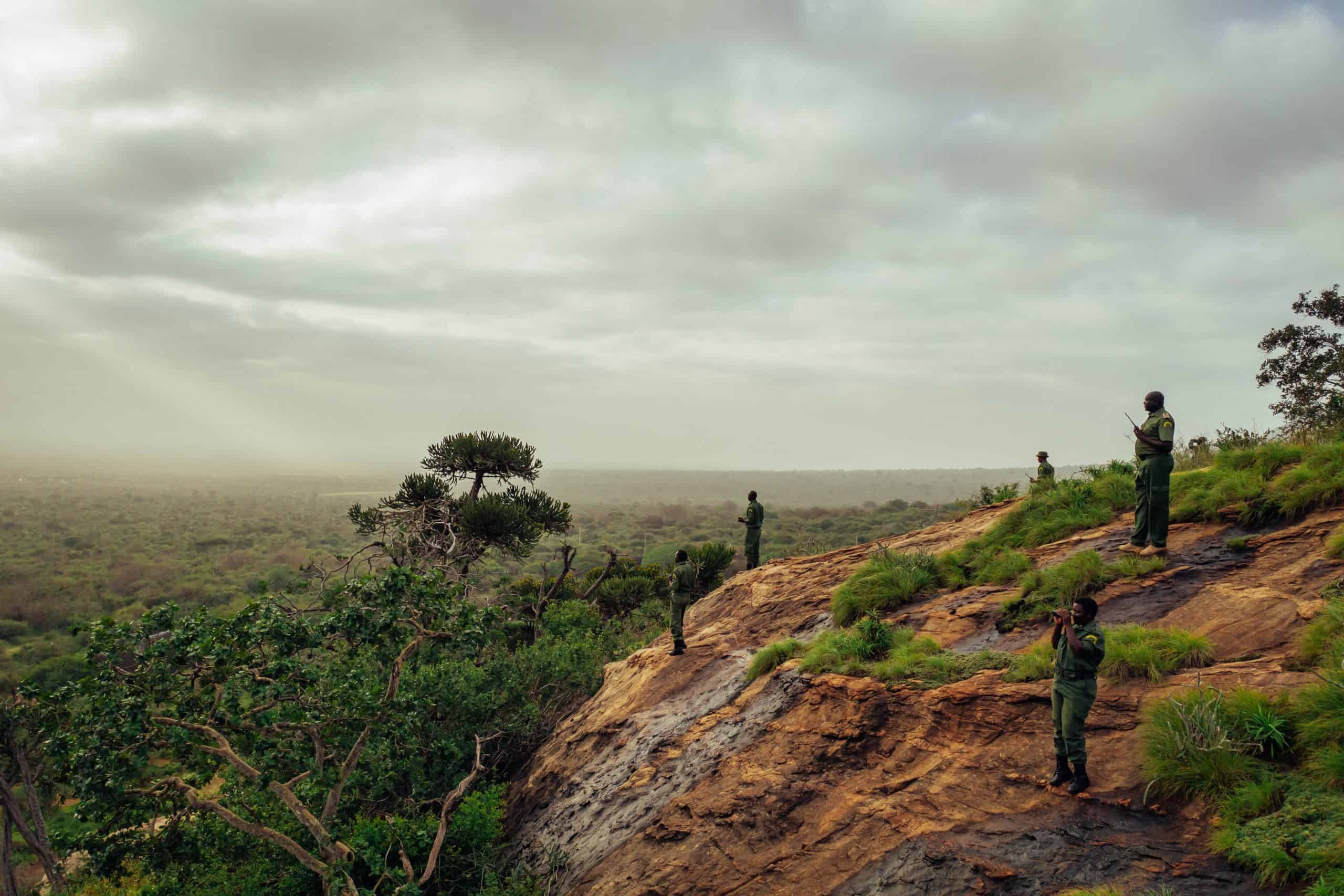
 The oxygen-producing tree, source of life
The oxygen-producing tree, source of life